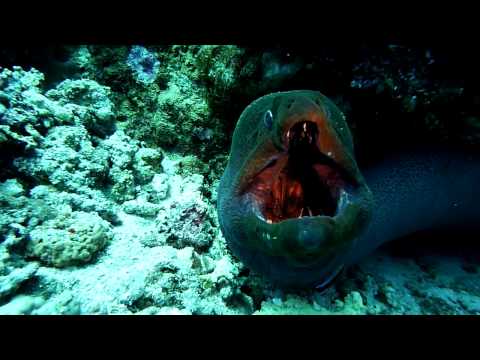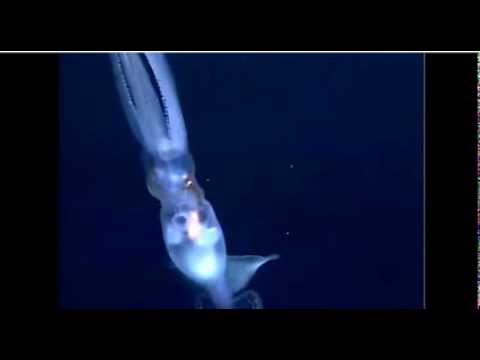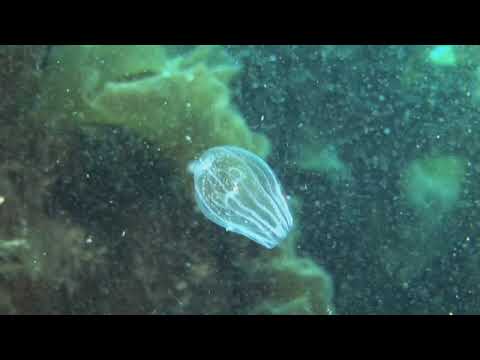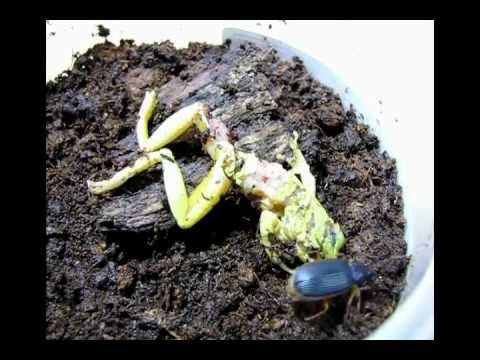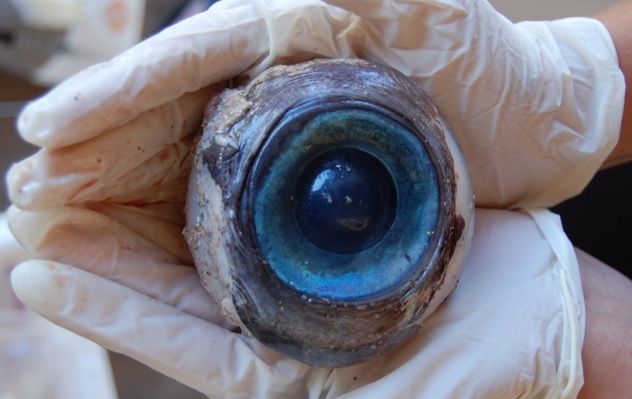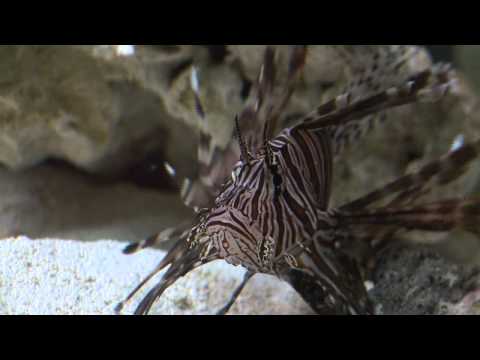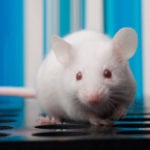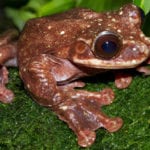10The Sea Star’s Extendable Stomach Strategy
Sea stars—once known as starfish—can’t see their prey, but they can detect and follow the chemical scents that it leaves behind. Once a sea star smells a clam, it uses hundreds of suction cup-like tube feet on the back of its arms to track down the clam and crawl onto its closed shell. The star then uses its feet to turn the clam around until the crack between its two shells is aligned with the star’s mouth. This crack is very small—roughly 0.65 centimeters (0.25 in) in diameter—but it’s never completely sealed. Then, via a bizarre move called eversion, the sea star extends its jelly-like cardiac stomach out of its mouth. It presses this stomach against the crack between the shells, forcing it to slowly seep inside and release small amounts of digestive juices into the clam. This weakens it and allows the sea star’s tube feet to pull the shells apart. The rest of the star’s stomach then enters the shell, and its digestive enzymes melt the clam’s body into a liquid soup. This is necessary because the sea star has no teeth or claws to rip the meat into bite-sized chunks. After absorbing the soupy food into its inner pyloric stomach, the sea star retracts its cardiac stomach back into its body. Any shell fragments or inedible bits are ejected out of the star’s mouth. Recently, Japanese researchers discovered that, even after wiring mussel shells shut, sea stars can still get their stomachs inside and eat all of the meat before the wires are removed.
9The Moray Eel’s Alien Jaws Strategy
Most fish eat by sucking water and food into their mouths. Other fish grab food with their jaws, using suction to move it to their esophagus. But moray eels can’t do either, so they feed on prey like they’re starring in the movie Alien. First, the moray eel grabs its prey with its toothy outer jaws. Then it uses a second set of jaws (called pharyngeal jaws) located in its throat to reach up, grasp the prey, and swallow it whole. It’s all over in less than a second. Eels are similar to snakes in that they have to eat large prey with a narrow mouth and then push the prey through their long, thin bodies. While other eels can feed by suction, researchers believe that moray eels developed this amazing second set of jaws because they hunt in spaces that are too small for their heads to expand to create suction.
8The Crocodile’s Bait-And-Switch Strategy
Until recently, crocodiles were considered to be the sluggish dullards of the animal kingdom. But it turns out these reptiles are far more clever than anyone realized. In India, researchers watched as crocodiles lay at the shallow end of a pond with small twigs or sticks on their snouts. They did not move for hours, but they weren’t being lazy. They were simply lying in wait for their prey, using the small branches as bait to lure in small birds hunting for nest-building materials. These poor birds flew in to grab the twigs, and the crocodiles immediately lunged and ate the birds alive. Despite their heavy armor, crocodiles are surprisingly sensitive to touch through small, pigmented domes sprinkled over their bodies. They feel vibrations and pressure better than we do with our fingertips. The nerves in their domed sensors are perfectly tuned to detect small ripples in the water and to pinpoint the exact location of their prey for an accurate strike. The most receptive sensors are near a crocodile’s teeth; scientists believe these sensors help them identify the type of prey that they’ve caught.
7The Humpback Whale’s Killer Bubbles Strategy
Lacking teeth, humpback whales use baleen plates—made of keratin and containing bristle-like edges hanging down from the upper jaw—to strain large quantities of herrings, krill, and other small prey for food. Watch this video on YouTube In addition, humpbacks are the only baleen whales that feed cooperatively, using bubble nets to trap their prey. The humpbacks work in teams (known as pods) of five to eight whales on average. Bubble net behaviors may vary by region and individual whales, but they generally appear to be a way for the pod to capture more prey than each whale could on its own. Sometimes, one pod will even steal from another’s bubble net. Using Southeast Alaskan humpback whales as an example, the hunt begins when a pod dives beneath a school of herring. The humpbacks then broadcast feeding calls to herd the frightened herring upward in a clump. The more selfish herring will seek refuge in the center of the school which, ironically, makes them more likely to be eaten. As the herring rush to the surface, the humpbacks release columns of air bubbles from their blowholes to encircle the fish in a bubble net. A school of frightened herring won’t swim through bubbles, so this prevents their horizontal escape. However, if individual fish get separated from the school, they might be able to cross the bubble barrier and escape unharmed (which is why hiding in the school’s center is such a bad idea). Once the herring are corralled, the humpback whales swim upward through the net with mouths open, and the fish are toast.
6The Squid’s Club, Flap, And Flutter Strategy
The average squid has eight arms and two tentacles. The tentacles are longer than its arms and have tips (also called clubs) with hooks or suckers. These squids shoot their tentacles forward, capture their prey with their clubs, and then bring the prey into their mouths. But there’s at least one type of deep-sea squid—Grimalditeuthis bonplandi—that engages in a novel battle strategy. In a way, it has no choice. The G. bonplandi is too weak and slow to hunt prey like the average squid. Its tentacles also lack hooks, suckers, and photophores (glowing spots used to lure food in). About a mile beneath the surface of the ocean, the G. bonplandi hangs motionless, with its arms outstretched in the water and its thin tentacles hanging down. The squid’s tentacles don’t appear to move independently, but rather fin-like membranes on the clubs flap, flutter, and seemingly swim away like small animals. The tentacles are dragged behind them but, even after the tentacles are fully extended, the clubs keep swimming independently. Due to the extreme depth and darkness of its home, researchers have never directly observed the G. bonplandi feeding on prey. But they believe that the swimming behavior of the squids’ clubs attracts shrimp and smaller squids. Without glowing spots, these clubs are invisible so when prey comes close enough, the squid may use its arms to trap these unsuspecting creatures. It’s also possible that the squids’ flapping clubs attract prey by roiling glowing microscopic organisms and creating a colorful glow in the water. Or, as one more theory attests, the vibrations and turbulence created by these clubs may fool prey into thinking that either their mates are signaling them or the movements are coming from prey of their very own.
5The Japanese Sea Catfish’s pH Meter Strategy
The nocturnal Japanese sea catfish lives around the southern tip of Japan and the Ryukyu Islands. John Caprio, a researcher at Louisiana State University, discovered that sensory nerve fibers on the catfish’s whiskers (also known as barbells) responded to minor changes in the pH (acidity) of seawater. Japanese sea catfish use these sensors to locate their prey—small sea worms called polychaetes. The polychaetes live in small tunnels of mud on the ocean floor. When these worms breathe, they exhale small quantities of carbon dioxide, which react with the seawater to form carbonic acid. This causes a slight decline of about 0.1 in the pH level of the water around the mouth of the worm’s home. When the catfish detects this change, it dives down and sucks the worms out of their homes. According to Caprio, “These fish are like swimming pH meters. They are just as good as a commercial pH meter in the lab.” The catfish’s fibers are most sensitive at natural seawater’s pH of 8.2. But once the level dips to 8 or below, the fish dramatically loses its food-finding capability. Scientists are concerned that global warming’s acidifying of our oceans may compromise this animal’s ability to hunt and capture its prey.
4The Comb Jellies’ Stealth Submarine Strategy
Comb jellies are often called comb jellyfish, but they aren’t actually jellyfish. They’re thin and transparent invertebrates of the phylum Ctenophora. Their name refers to their comb-like ridges, along which thousands of cilia act like tiny propellers that simultaneously transport the jellies through water while creating a current to draw in food. Their movements generate a beautiful flashing rainbow from light refracting off the cilia. Comb jellies don’t have a brain or any other special senses—just a simple nerve net that detects chemical traces of their prey in the water. One species—the North American comb jelly—is a voracious creature that eats large quantities of zooplankton. These creatures are sightless and thus unaware of the rainbow light show, but some—such as copepod plankton—are quite sensitive to even minor disturbances in the water. To catch the vigilant copepods, the comb jellies have to approach just like a stealth submarine. They move almost impossibly slowly so they can sneak up on their prey without detection. The jellies thus don’t create turbulence, so once they open their mouths the blind zooplankton simply swims inside. By the time they realize where they are, it’s too late to escape.
3The Ground Beetle’s “Make My Day” Strategy
Normally, frogs eat bugs. But ground beetles of the genus Epomis have no interest in that, luring their potential predators into becoming a victory dinner and succeeding at almost every attempt. In this predator-prey role reversal, the beetle patiently moves its mouthparts and antennae to get the attention of toads, frogs, and other amphibians. They’re intensely goading these creatures, like Clint Eastwood taunting, “Go ahead. Make my day.” Finally, the frog attacks, but the beetle avoids its tongue and attaches double-hooked mouthparts to it instead. The beetle then begins to suck out fluids while chewing the frog’s body. Almost always, the Epomis kills the much larger amphibian and enjoys a delicious meal as a reward.
2The Swordfish’s Hot Eyes Strategy
While leaving the rest of their bodies cold-blooded, large and powerful sea predators like swordfish use a lot of energy to keep their eyes warm. This gives them superior vision to catch fast-moving prey such as squids. To warm the blood that goes to their eyes and brain, swordfish have adapted a muscle—originally meant for eye movement—into a heating organ. This lets swordfish warm their tennis-ball-sized eyes about 10–15 degrees Celsius (50–60 °F) higher than the water in which they’re swimming. In scientific tests, swordfish eyes heated to 20 degrees Celsius (68 °F) were able to capture light over 10 times faster than eyes kept at ocean temperature, which is about 3 degrees Celsius (37 °F) at the coldest depths. This visual processing works like a camera with a fast shutter speed. Instead of a blurred picture, the swordfish can see its fast-moving prey more clearly in the cold, murky, yet still well-lit depths of the ocean—often about 300–500 meters (1000–1650 ft) down. Squid and other prey can’t see it approach because these prey can’t warm their eyes, and thus everything remains difficult to detect.
1The Lionfish’s Terminator Strategy
Most predatory fish hunt prey that travel in large groups because it takes less energy to catch them. When the amount of prey declines too much, the predator fish simply relocates to other regions with more dining options. Lionfish, on the other hand, operate more like the Terminator, preferring to stay in one region until their prey is locally extinct. Native to the Pacific Ocean, lionfish are beautifully colored with large, spiny fins. The bold colors don’t hinder them, as their sharp, poisonous spines protect them from other marine life. Lionfish have been able to hunt almost unchecked in the Atlantic Ocean and parts of the Caribbean since the late 1980s, when fish hobbyists and local aquariums were believed to first place them into waters off the coast of Florida. The native fish there don’t realize the lionfish are dangerous to them. By fanning their fins, lionfish drive smaller prey into a corner and swallow them in a quick surprise attack. Lionfish have eliminated over 90 percent of the native fish in some Atlantic regions. In an effort to control this environmental menace, scientists have removed vast numbers of them from certain reefs to create safe havens where native fish can repopulate. Where lionfish numbers have been reduced by 75–95 percent, native fish have recovered by 50–70 percent. That’s encouraging news, because it’s almost impossible to completely eliminate lionfish from these regions at this point.

